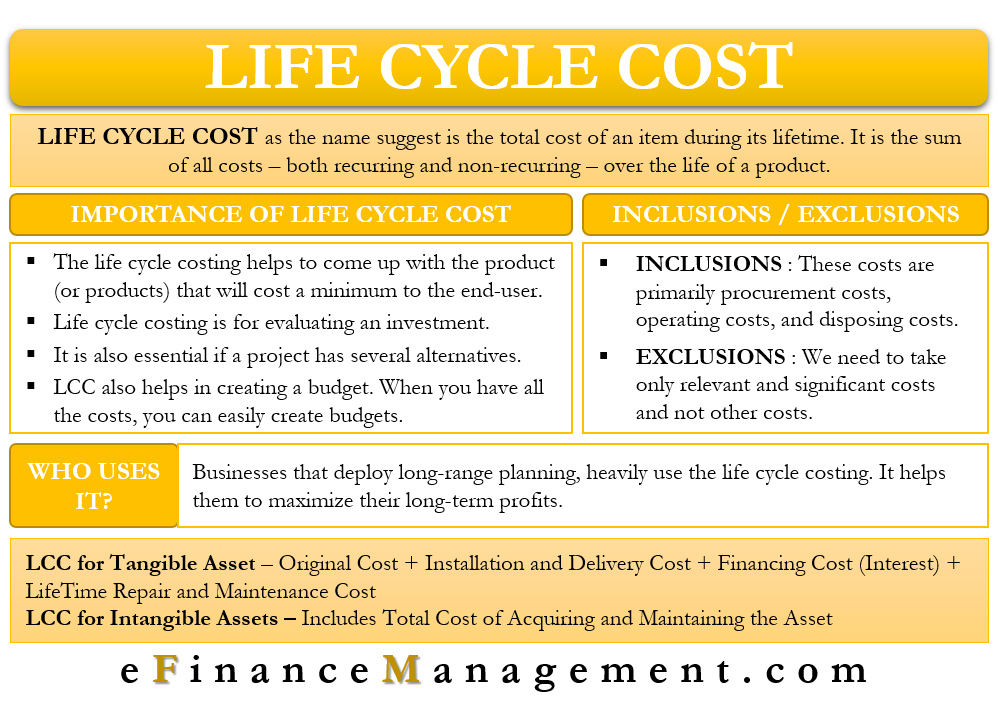Life Cycle Cost (LCC), or whole-life costing, as the name suggests, deals with the total cost of an item during its lifetime. Or, we can say, it is the process to compile all costs that a company incurs over a life span of a product, service, asset, investment, project, structure, or system. It is the sum of all costs – both recurring and non-recurring – over the life of a product.
The costs that it includes are the purchase price, cost to install it, cost to operate it, maintenance and repair, and upgrade cost (if any). In short, we can say the costs would include initial investment, any further investment, recurring expenses, and disposal expenses.
A straightforward example of LCC is buying a car. The purchase price is not the only price that you pay for the car. During the car’s lifetime, you also need to pay insurance, road tax, repairing, maintenance, and petrol or diesel costs.
Life Cycle Cost – Importance
The following points highlight the importance of LCC:
Life Cycle Cost concept is relevant in several fields. The estimate of the life cycle cost plays a pertinent role in deciding whether or not to acquire an asset. Management analyses the cost of owning and operating the asset and usually considers an asset that costs the least. The expenses that management considers include purchase price, installation, operating, financing, depreciation, maintenance, and disposal.
Also Read: Types of Costing
When talking of production, the life cycle costing helps to come up with the product (or products) that will cost a minimum to the end-user. Further, products with a minimum after-sales cost are preferred. These costs include the cost of warranty, replacement, and field service work.
We can also use LCC for evaluating an investment. The total cost would include the cost of obtaining, maintaining, or renewing, and disposal.
The analysis of the Life Cycle Cost is also essential if a project has several alternatives. These alternatives differ from each other in terms of costs that are necessary to complete the project. In such a case, management selects an alternative that can generate maximum savings. The preferred alternative is that it minimizes the initial cost, as well as the operating cost.
LCC also helps in creating a budget. When you have all the costs, you can easily create budgets.
Who Uses Life Cycle Cost?
Businesses that deploy long-range planning heavily use the life cycle costing. It helps them to maximize their long-term profits. A business that does not consider LCC as important may likely buy assets at a lower cost. However, they ignore the costs they may incur during the asset’s useful lives.
Which Costs to Include?
There could be several costs in the lifetime of a product, asset, or project. These costs are primarily procurement costs, operating costs, and disposing costs. Under these costs, there could be several sub-costs, such as fuel, repairing, maintenance, replacement, and more.
However, we must not consider all costs for life cycle costing analysis. Instead, we need to take only relevant and significant costs. A cost is said to be relevant if they can have a dependable impact on the project’s life cycle cost.

LLC of Asset
We have already discussed above the LLC costs for an asset. Let us understand the concept with the help of an example. Suppose you buy a printer, which has a purchase price of $1,000.
Next, you pay $100 as the delivery and installation fee.
You purchased it using a financing option. So, including interest, the printer will cost you $1,050.
For the lifetime of the printer, you estimate that the printer would use ink cartridges totaling $1,000 and electricity of $100.
The lifetime maintenance and repair cost is estimated to be $500.
If we total all these costs, the $1,000 printer will cost you $2,750. In reality, it would cost you even more as we have not considered depreciation and disposal expenses.
LCC of Intangible Assets
Intangible Assets are the assets that you can’t see or touch, such as patents, goodwill, etc. LCC of an intangible asset will include the total cost of acquiring and maintaining that asset. For instance, you pay a purchase amount for the patent. Also, you hired a lawyer to do the paperwork, and you will have to pay annual fees to maintain the patent. All these costs will constitute LCC.
For goodwill, you will have to consider all costs that go into establishing it—for instance, the cost of a logo, ad campaign, website, and more.
Life Cycle Cost Analysis (LCCA)
Such an analysis helps to estimate the total cost of a project and its alternatives. After that, the management can use it to select the right alternative that would lower the cost of ownership without compromising on the function and quality.
One needs to perform LCCA at the very start or when the design process starts. Starting at the initial stage ensures enough time to make changes, which in turn helps to reduce the life cycle cost. The first step of LCCA is to decide the impact of the options available. After that, we need to quantify those impacts in monetary terms.
One needs to discount all the future costs to the present-day amount. It makes it easy to find the present value of the life cycle cost. One may also use historical data to determine the cost accurately. To make the process easier, you need to first determine the fixed costs and then estimate the variable costs.
Final Words
LCC could prove very important if a company can use it accurately. However, to derive maximum benefit, a company should have the expertise to foresee the expense that it would incur on the asset, product, project, or investment.


It’s really very good and simple language made to understand difficult concepts.
You are most welcomed